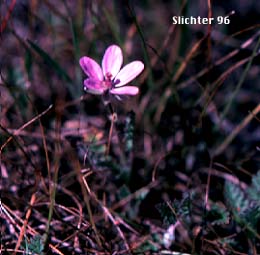Filaree in bloom atop Mill Creek Ridge, Wasco County, OR.....March 17, 2020.
Filaree is also known as stork's bill, crane's bill, and heron's bill. It is an annual, winter annual or biennial weed introduced from Europe. The leaves are mostly basal with individual leaves pinnately compound. The petioles are usually reddish in color. The leaflets are sessile and irregularly shaped with incised margins. Individual leaflets range from 1-2.5 cm long The leaves are covered with short, stiff hairs. Stems are short and have several reduced leaves which are opposite one another.
The inflorescence consists of umbrella-shaped clusters of 2-12 pink to purplish flowers. Individual flowers measure about 1.5 cm across with 5 petals, 5 bristle-tipped sepals, 10 stamens and a single, 5-parted style which measures from 2-4 cm long. The flower stalks measure from 1-2 cm long.
Filaree may be found on disturbed, barren hillsides and on the drier plains.
Filaree is a native of the Old World. It is now found throughout much of Canada and the United States.

